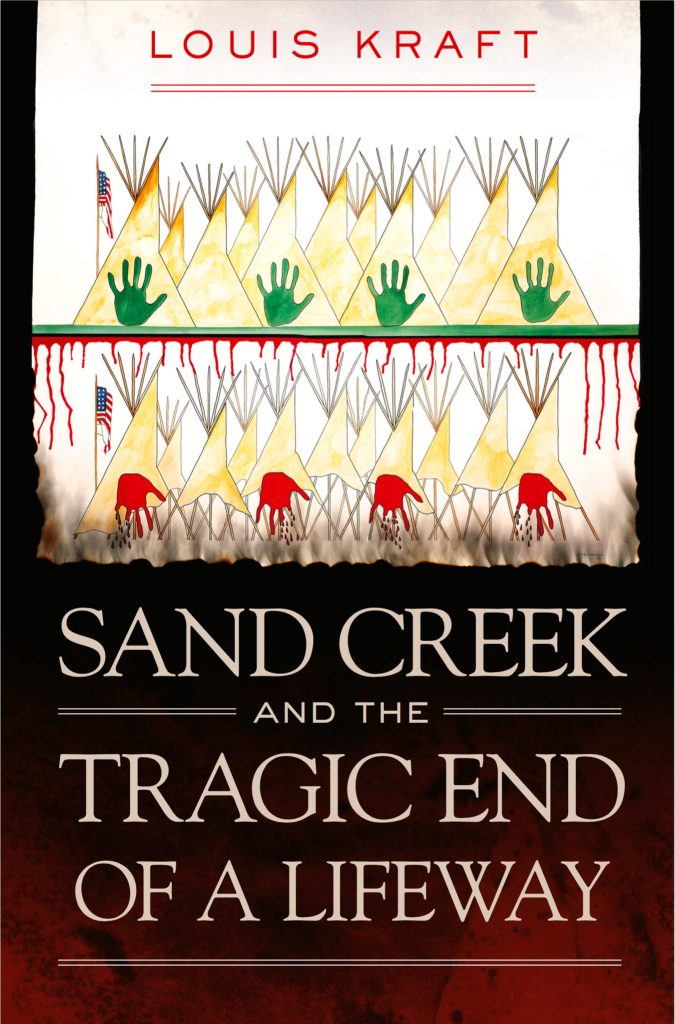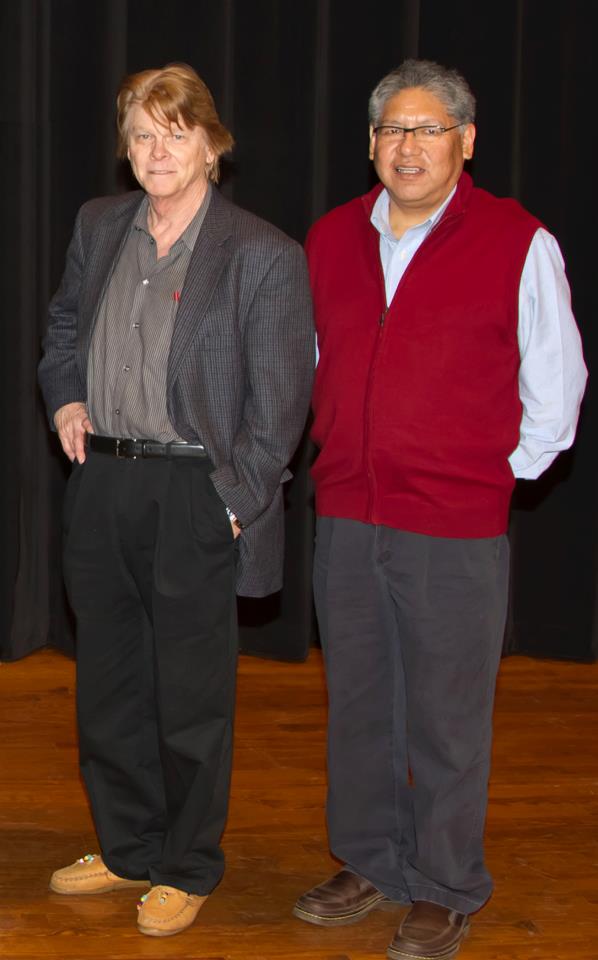Website & blogs © Louis Kraft 2013-2020
Contact Kraft at writerkraft@gmail.com or comment at the end of the blogs
More’s a comin’ …
More’s a comin’ … and this has been a comin’ for a long-long time. The University of Oklahoma Press will publish Sand Creek and the Tragic End of a Lifeway in March 2020. The book cover design has been completed, and the art is the only image I ever considered for the dust jacket. In 1999 I met Cheyenne chief Gordon Yellowman, when we both spoke at a major event at the Fort Larned National Historic Site in Kansas. During the conference Gordon and Cheyenne chief Lawrence Hart blessed the Cheyenne-Dog Man-Lakota village, which is some 35 miles to the west of the fort (it was added to the National Register of Historic Places on June 17, 2010). During the day of the talks, Gordon was selling prints of his painting, “Sand Creek.” I bought one, framed it, and it has been displayed at Tujunga House ever since. He was thrilled when I called him to ask if I could use his art on the cover. When he said, “yes,” I was more thrilled.
Gordon Yellowman’s art symbolically shows the Sand Creek village on November 28, 1864, and then on November 29, 1864. The book is now listed on Amazon; it includes the dust jacket copy, which gives you a good idea of what the book is about: Sand Creek and the Tragic End of a Lifeway on Amazon for pre-order.
To keep this short, … I show, that is show and not tell, the story from all sides. Cheyennes and Arapahos, whites that married into the tribes, their offspring, whites that coveted Indian land, and whites who spoke out against the massacre at Sand Creek (Colorado Territory). There are no good guys and no bad guys; they are all just people. I use their actions and words to show you who they were …
The scope and the problem that it presented
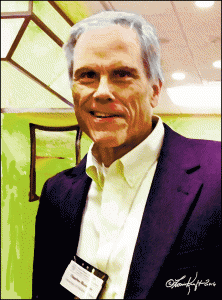
LK portrait of Chuck Rankin, which is based upon a photo of him that Pailin took of him at the WHA convention in Newport Beach, Calif., on 17oct2014. (art © Louis Kraft 2014)
From the beginning when former OU Press editor in chief Chuck Rankin and I were working on trying to come up with a story idea that that both of us would agree to, this has been pure hell. To begin with, I didn’t want to write the book. However, if I did, the scope would be large and not focus on an attack on Cheyenne and Arapaho village circles camped on Sand Creek in Colorado Territory on November 29, 1864. These people thought that they had been removed from the 1864 Cheyenne war, and were at peace until they heard otherwise from the U.S. military. This I made clear to Chuck, and we talked and then talked more and more. I’m one lucky cowboy to have had Chuck in my corner, for without him I would have never have agreed to write this book. Egotism aside, and regardless of what anyone thinks of Sand Creek and the Tragic End of a Lifeway, it will be the most important book that I ever write. Chuck, thank you from the bottom of my heart.
The Sand Creek manuscript status …
I don’t know. I hate to say it, but this is the story of my life—I don’t know.
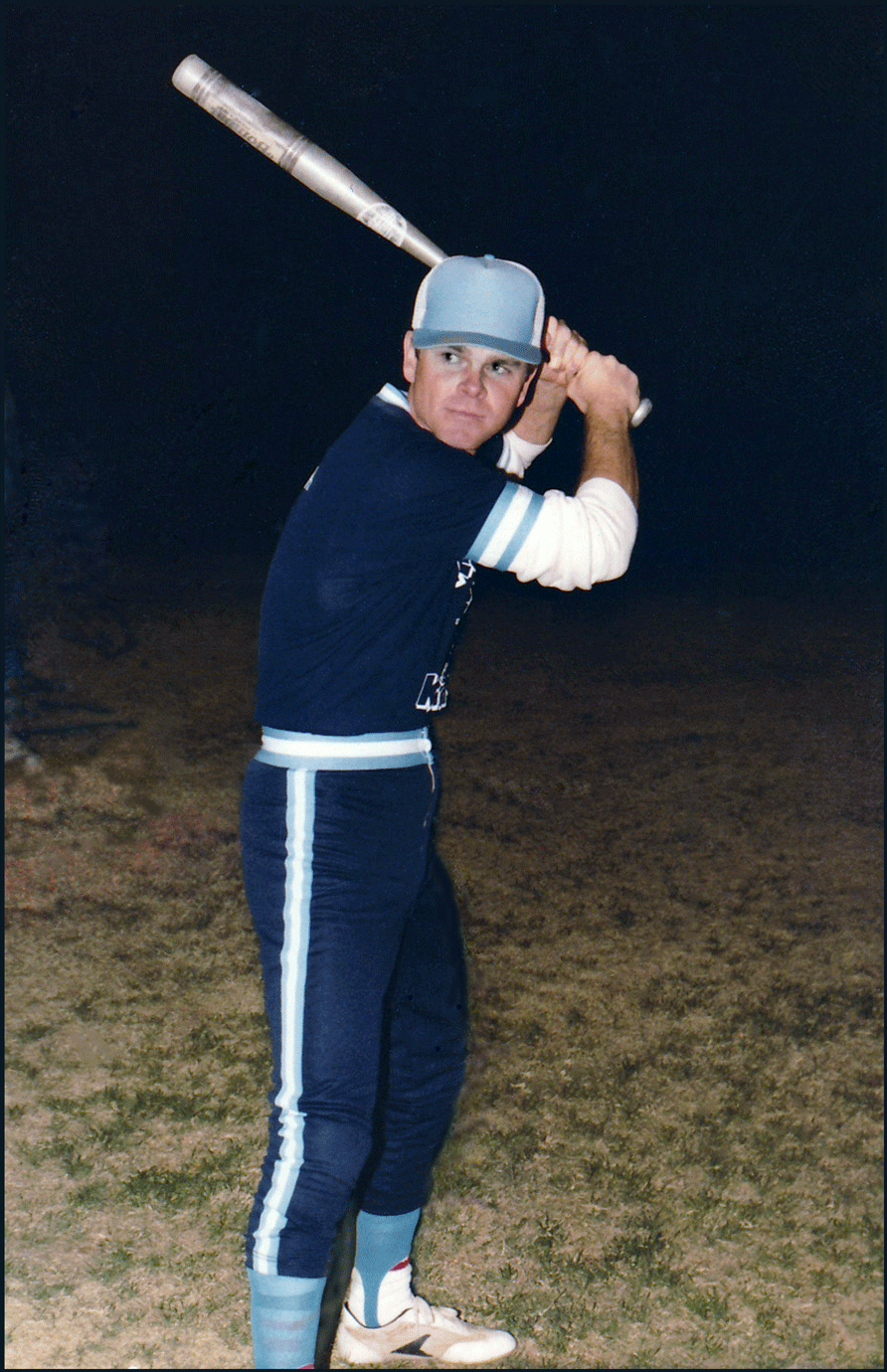
This photo was taken in early 1980. Shortly after the time of our mother’s death (4jan1980) my brother Lee and I, along with some of his friends (all of whom I knew), created a ball team—the Kool-Aid Kids. It was the beginning of a golden decade for both of us as we eventually had three seasons and played year round. We had always been close, but these years linked us forever. This ended on 6mar1990 when Lee died in a car wreck (he was a passenger). This day was, and still is, the most devastating day of my life. (photo © Louis Kraft 1980)
I know what I’m doing to try and make something happen in 2020. Will I hit a home run (we’re talking baseball here)? My batting average is pretty good, so whenever the opportunity is in front of me I swing for the fence. Sometimes I hit a home run, and sometimes I strike out. There’s a saying in baseball, and it is important. If you don’t come to the plate and bat, you can’t strike out. At the same time, you can’t hit a home run. The risk of striking out is worth the chance of hitting a home run.
The copyedits of the Sand Creek manuscript
The day before Pailin’s birthday (July 5), we hosted our second annual July 4th party. I began my edit of the first Sand Creek copyedit on the evening of her birthday and delivered it on deadline (August 5). This wasn’t easy for I was blindsided by an editor who was clueless (and I’m being very kind here). Without communication or warning, I received all the pieces of the entire copyedited manuscript in one delivery—and faced the massive task of fixing what was initially correct in my draft but was now was a massive collection of errors. Trust me when I say that this copyeditor pushed me to the boiling point. I actually called University of Oklahoma Press managing editor Steven Baker and screamed at him: “Does she know anything about the Cheyenne Indians or the 1860s Cheyenne wars?” “No,” he replied, “but she’s a good copyeditor.”
I insisted upon a second copyedit and got it. By this time I had no trust in what might happen, and my seven-day weeks have been long with no end in sight. But this is little more than a two-headed dragon, for sometime—hopefully no later than now late-October—I will complete my work on the second copyedit. At that time my future will be before me.
I can’t begin to tell you how important the copyedits of my books are.
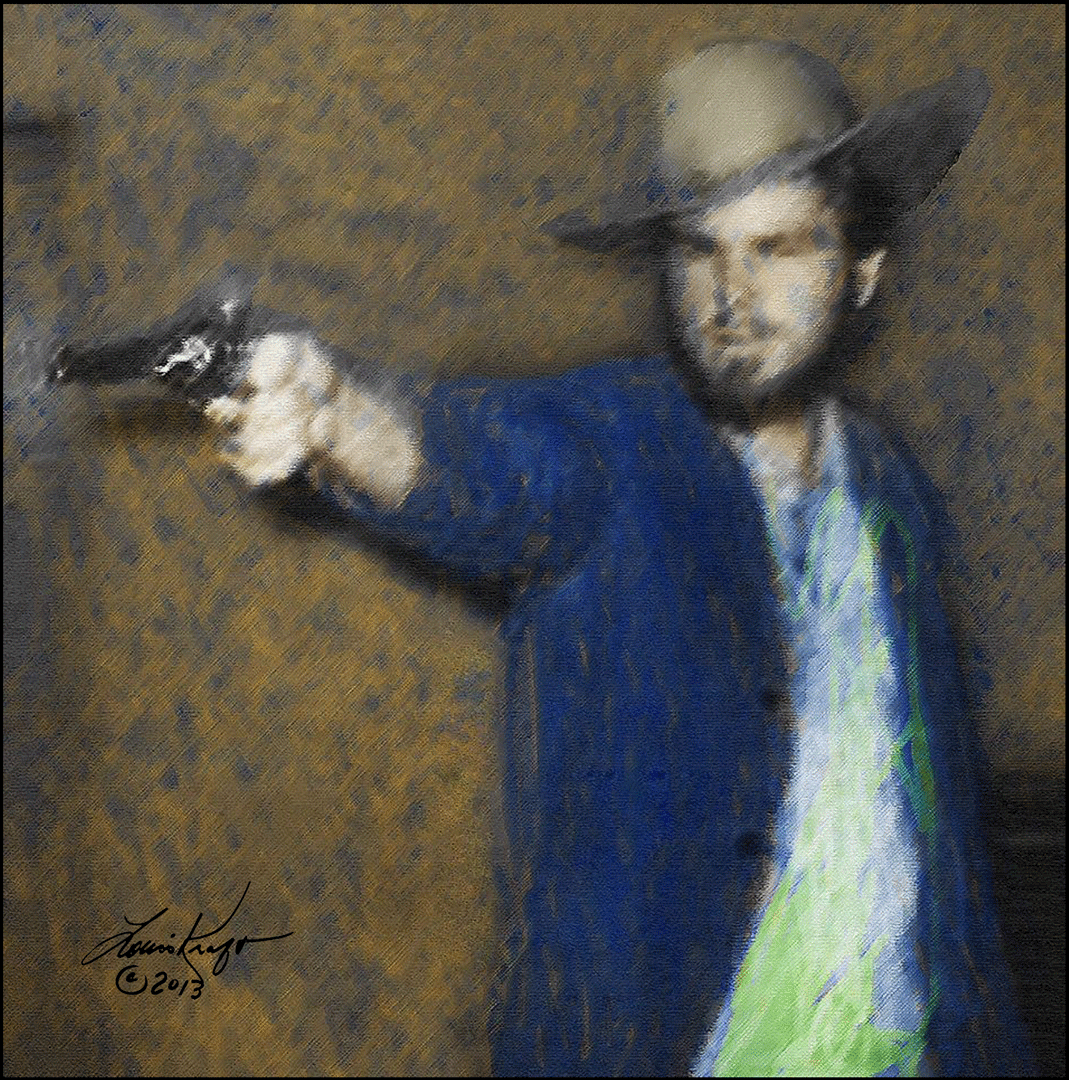
I do a lot of research, and luckily have a wealth to explore from my family (trash to others but luckily given to me; much of which I never knew existed). I created this art from a totally degraded b&w negative that could never be restored or printed that dated to 1972, and better I used it as the feature art for a blog that dealt with me being trapped in the bathroom on 18jun2013. I played it for laughs, and if you choose to look at it (A gunslinger in a bathroom), I hope that you chuckle. For the record, I don’t think much of writers who view their writing as God’s gift to the world. This said, methinks I should use this art whenever I again talk about them. (art © Louis Kraft 2013)
Believe it or not, I know writers that are clueless to what a copyedit is, or worse writers who aren’t open to constructive criticism to improve their work—if we can call their writing work—for the simple reason that they claim that they are brilliant. For the record I have never completed reading a book by a self-proclaimed “brilliant” writer, and all of their tomes that I unfortunately bought (or they gave me) have either been trashed or donated to the Vietnam Vets. All of them.
Back to the copyedit; my editor did improve my manuscript when she stuck to copywriting and stopped spouting nonsense and crap about people, culture, and facts that she knew nothing about and located haphazardly on the internet. This is exactly what copyediting is supposed to be—improving the delivered manuscript’s word usage and paragraph structure. While fine tuning my wording, she questioned events and facts (which is good), presented ideas, and so on. … Some I accepted, some I rejected; but I always shared my reasons for what I did. Always. This is what a copyedit is all about—fixing, improving, polishing. There is one goal for the copyeditor and the writer, and that is to make the final book as good as possible. … As far as I’m concerned, every writer who disses this has his or her thumb stuffed where the sun doesn’t shine.
The blurb for the dust jacket
Let’s be clear here: the dust jacket blurb, and it doesn’t matter if it is on the back of the DJ or on the inside flaps—it is a selling tool. … A major selling tool, and a good one can sell additional books while a not-so-good one will not help sales (and may perhaps hurt them).
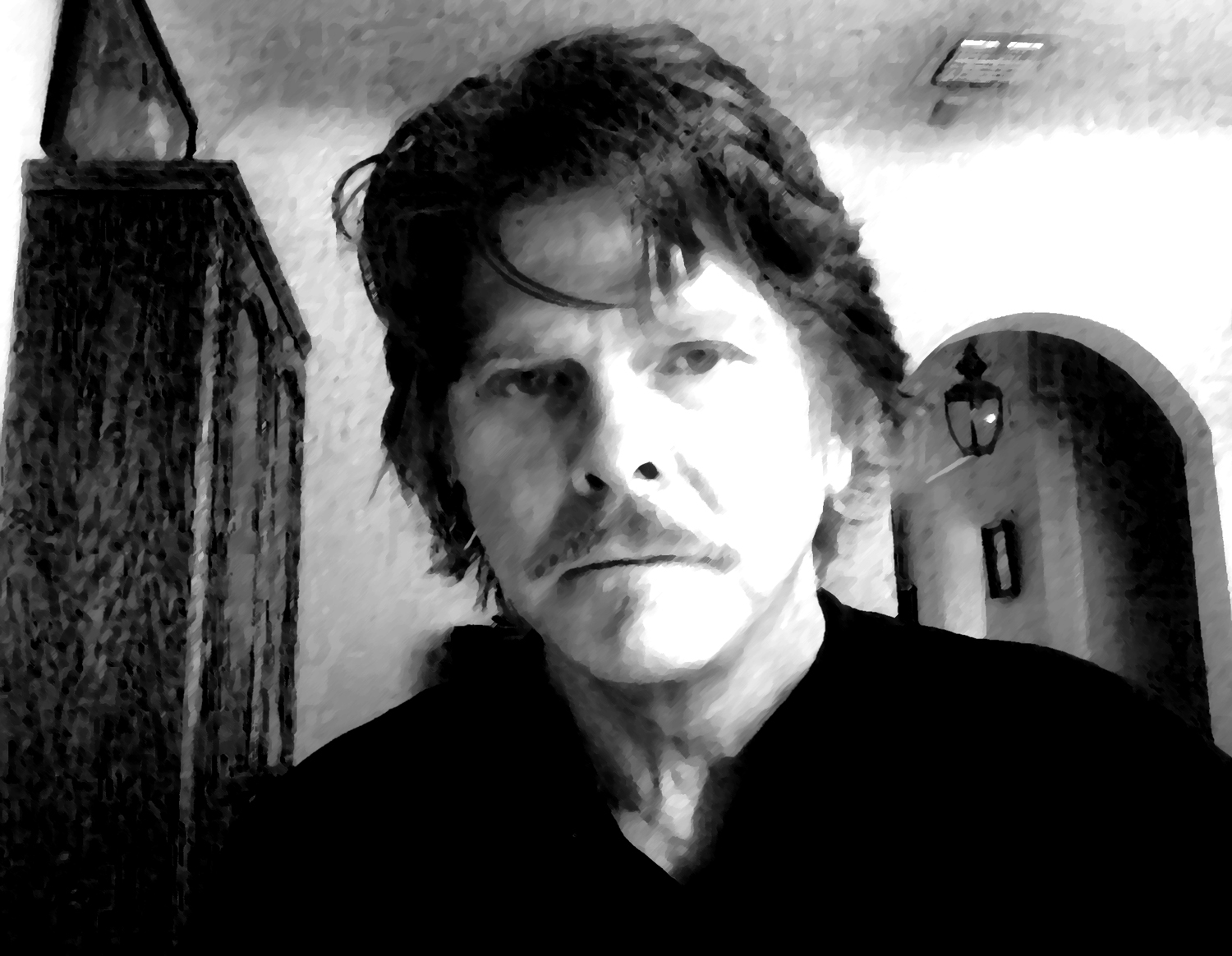
LK is easy going. I am also intense with a take no prisoners attitude. I’m sorry for this, but it’s just me. I have a vision for everything that I write, and I want to see it through to print. This said, I love my editors and my art directors, but will always challenge them whenever I think it necessary. The photo for this image was taken at Tujunga House on 30may2013. (image © Louis Kraft 2013)
This moves us into the land that I have invaded time and again as I insist in taking a major role in the entire production process of my books (and articles). Editors and art directors do not like this, for, I believe, that their view is that the writer’s work is complete when the final edit is accepted—meaning that the writer fades into the background. Not so with this writer. Good or bad, the book or article is my vision and I want t do everything possible to insure that my vision will see print.
In August I received the draft of the blurb for the dust jacket flaps. It was a good draft with only 10-plus words that were vague or I objected to as they were off target or erroneous. I completed my edits before my August deadline, and am happy with the prose. The final draft is on target and it hits home for the entire book. Luckily I have a get out of jail ticket, for all of the writing and copyedits. Done deal, and the dust jacket blurb will grab potential readers as much as the great dust jacket cover will.
I really want to share what I consider the final dust jacket blurb, but it must be a surprise come March 2020. Regardless of what you think about what is on the dust jacket flaps, I do believe that it will generate book sales to anyone who reads it. Yes, it is that good.
The maps
The three maps are complete, and again Bill Nelson created them from my drafts. Magnificent work by him, and I’m thrilled. Two are similar in design to the maps in Ned Wynkoop and the Lonely Road from Sand Creek. The third map was a major challenge for me and for Bill. It is complete, it will be two facing pages in the printed book, and it will be an eye-opener.
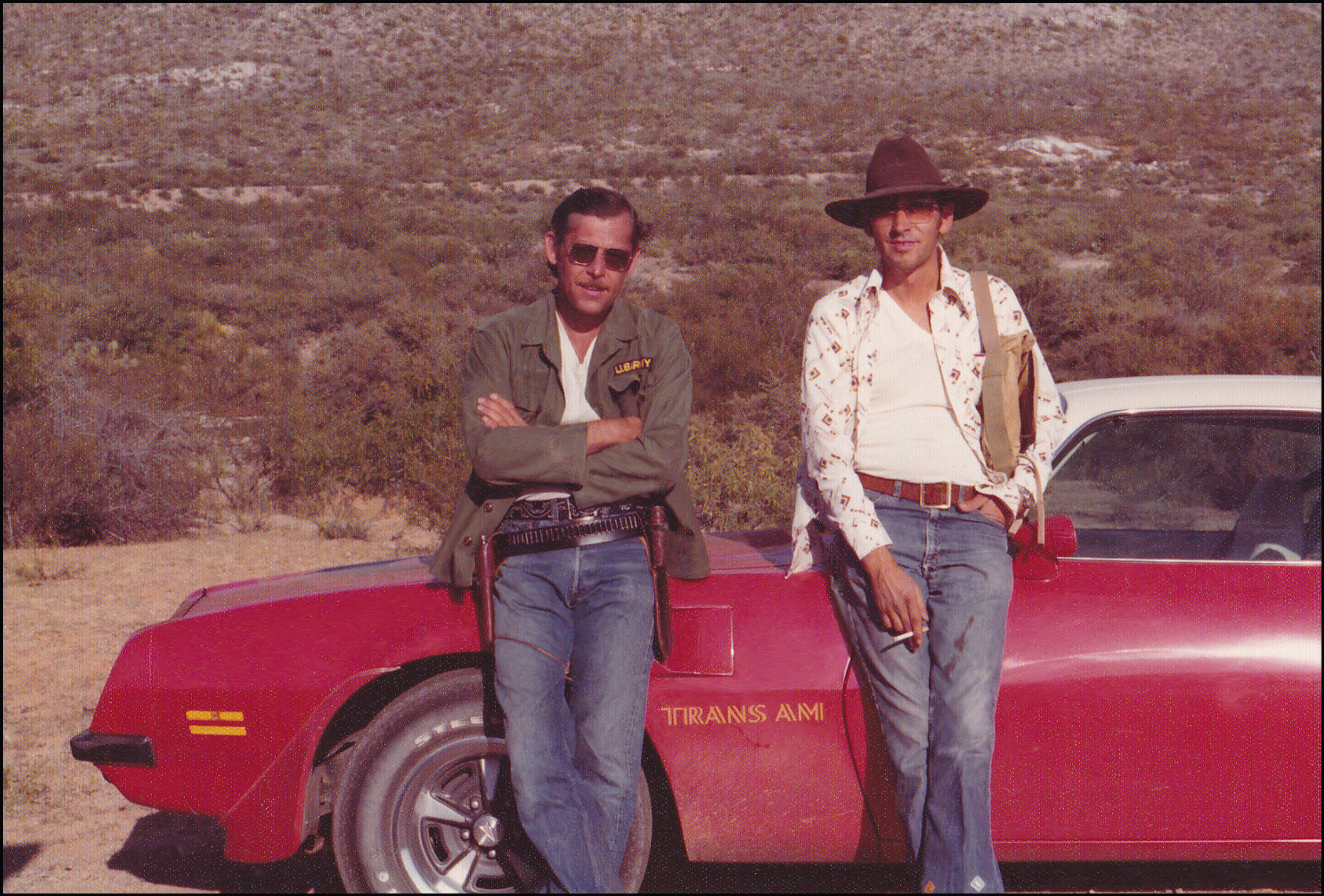
My bro Glen Williams (left) and his brother Joe Franklin Williams during a September 1976 road trip in his 1974 Pontiac TRANS AM (400 cu inch V-8). A cool photo taken during one of their trips, and as Glen told me, on “dirt and gravel backroads of the Arizona desert making frequent trips … in Apache territory [while] search[ing] old towns, railroad track beds, Apache sites and generally spent our week exploring Indian land and points of interest.” I wish I could have joined them, and more, had known Joe (who was 16 months older than Glen). (photo © Glen Williams 1976)
Sorry folks, but no mas here (meaning in English, nothing more is going to be said about this map on this blog). I do love being a tease. Buy the book and see the map, for it will not appear in my blogs.
The designed Sand Creek book proof and the index
The designed Sand Creek book is in my near future. I had thought that I would see it in mid-September. That has turned out to be wishful thinking, to my disappointment.
The first draft will include where I have indicated that the photos, art, woodcuts, and maps will be placed in the printed book. I will, if lucky, now see this draft sometime in late October, but I’m getting antsy on this. Originally I thought that I would see it before now—this isn’t on me, as I’m making my deadlines to get Sand Creek and the Tragic End of a Lifeway published in spring 2020. This reason is not for these blogs, although there may be a small LK headline in the future that I don’t want to happen. The page numbers for the book will be in place and firm. This means two things. I will review the text, but with all edits not increasing or decreasing line flow of the draft. At the same time I will begin to create the index (something that I have done for all of my nonfiction books). I currently have a 26-page mockup index that is ready and waiting for me to complete. If, and as with previous books, I will then see one final proof, wherein I can still make small corrections before the book goes to publication.
The LK 2020 Sand Creek future …
There are three things in LK’s Sand Creek future: talks, articles, and a major delivery to the Louis Kraft Collection in Santa Fe.
Five speaking pitches are underway
I am only going to pitch five talks for 2020. All will require my usual salary and all expenses (except for LA—it won’t have expenses, as I live seven miles from the location). All are major destinations, and I am taking my time to make certain that the proposals are specific to each venue and are clear why a talk is important. I am only considering speaking about two subjects next year:
- The attack on the Sand Creek village on November 29, 1864
- The life and times of Cheyenne chief Black Kettle
 Photo of LK (left) accepting the 2012 Western Heritage Award in Oklahoma City in 2012. I’m good at talking engagements. I’m also good when accepting awards, which are much more impromptu. This mounted cowboy bronze (you can barely see him in the lower left of the photo) weighs about 18 pounds (and I kissed him during the talk, which garnered me a nice laugh).
Photo of LK (left) accepting the 2012 Western Heritage Award in Oklahoma City in 2012. I’m good at talking engagements. I’m also good when accepting awards, which are much more impromptu. This mounted cowboy bronze (you can barely see him in the lower left of the photo) weighs about 18 pounds (and I kissed him during the talk, which garnered me a nice laugh).
How I’ll handle both talks (Sand Creek and Black Kettle) have been in place for a long-long time. Both will be unique, and I hope to develop them into long features for magazines (minimum of 3600 words). These article pitches are not yet in development.
One of the talk proposals was a verbal pitch to Kevin Mohr, chief of interpretation & operations at the Washita Battlefield NHS (see Gordon Yellowman below), and two written proposals have been delivered (the other two written proposals will soon be sent).
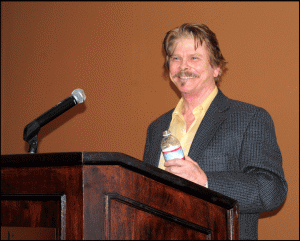
Believe it or not, this September 2013 Gatewood/Geronimo talk in Tucson was the last that I ever gave. Good times for LK, but times long gone—times I hope to bring back to life. Time will tell.
Those of you who follow these blogs know that I stopped giving talks in 2013. This was because of two reasons. I needed to complete the research and writing of my Sand Creek manuscript, but also, and just as important, I had stopped writing for software companies in April 2012. … But there’s more here, and I should say something about this. In 2012, I earned a lot of money. This meant that I could talk anywhere I wanted that year and the next. Some of these talks pulled in my requested salary and all expenses, but others did not and cost me a lot to appear. This was fine, as I felt that the venues and my subjects were important and I wanted to do them. So much so, that I did them while knowing that they would impact my bank account. This was how I felt then, and this is how I still feel today. All those talks in 2012 and 2013 are good memories for me (and will forever be so). Life goes on, but today is not yesterday. The past is the past, and it will never be the future.
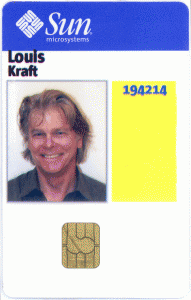
This Sun Microsystems badge was the only software badge that I ever ever scanned. My relationship with them ended in January 2009 when the company spiraled toward end of life.
I can’t understate the impact this has had on my life. No matter how good, or how bad, or how much I totally enjoyed the thrill-ride to deliver accurate prose on deadline for companies on the cutting edge, there was a bottom line. They allowed me to travel for research and deliver talks to my heart’s desire. I can’t begin to tell you what a loss this was, and how it has affected my entire writing life.
It’s September 2019, and I know where I would like to speak in 2020. Oh heck, silence isn’t golden here. My cities of choice are Los Angeles, Denver, Albuquerque, Oklahoma City, and Cheyenne. Cheyenne? Cheyenne? Where the hell’s Cheyenne? For those of you who don’t know, Cheyenne (Oklahoma)—or more precisely the Washita Battlefield NHS—has been a destination of mine for a long-long time.
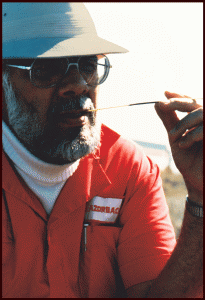
Jerry Russell relaxing on the private land that would eventually become the Washita Battlefield NHS (Cheyenne, Okla.). (photo © Louis Kraft 1987)
The first visit was in I believe 1987 when Jerry Russell’s Order of the Indian Wars ended their yearly meeting by visiting the Washita battle site that was then on private property. At that time I was tracking George Armstrong Custer in the north for articles. I called Jerry and asked if I and my family could join him for the trek to the Washita and then attend the banquet. We had a good relationship, and he said, “yes.”
My daughter and I flew to Oklahoma City before the 1991 Western Writers of America convention and drove to Cheyenne to get the lay of the land. The Washita battle site was still on private land, but I wanted to get a feel for it, and approached it from various angles. Binoculars gave me detail, but I didn’t know what I was looking at. I saw the hills, the valley, bits and pieces of the river, but none of it was usable. As we began to return to OKC a rainstorm pounded the earth. It was so bad that the windshield wipers were useless and there was zero visibility—a long 30 minutes waiting on the side of the road wondering if we’d be rear-ended by a driver pressing onward when he/she should have waited while Mother Nature thrashed the land. … I had previously been there in 1970 when I was a member of VISTA (Volunteers in Service to America). I lived in a converted garage owned by a single mother who had a teenaged daughter on the east side of the city. I was assigned to work with African Americans (they weren’t called this then), and two VISTA recruits also lived in the garage with me (one white and one black; we had had four female coworkers, one of whom was black, but they they lived elsewhere). I quickly learned that Blacks had no love for cowboys. I wore cowboy boots, but luckily brought a pair of black laced shoes; my supervisor—Cheetah Gates, who had a large Afro—told me that if I wanted to live I had better ditch the boots. I did. More importantly, I became one with the Black community. I walked the streets day and night; safely. I hung out in bars, restaurants and front porches, spoke with everyone, and bonded with the people I worked for, as well as some American Indians. Good memories here—memories that would influence my future, although at this time I was clueless of what my life would become.
After the WWA convention my daughter and I drove to Kansas to see Medicine Lodge Creek, and most importantly the Fort Larned NHS. This trip was one of the keys to my entire writing future, although again I didn’t realize it.
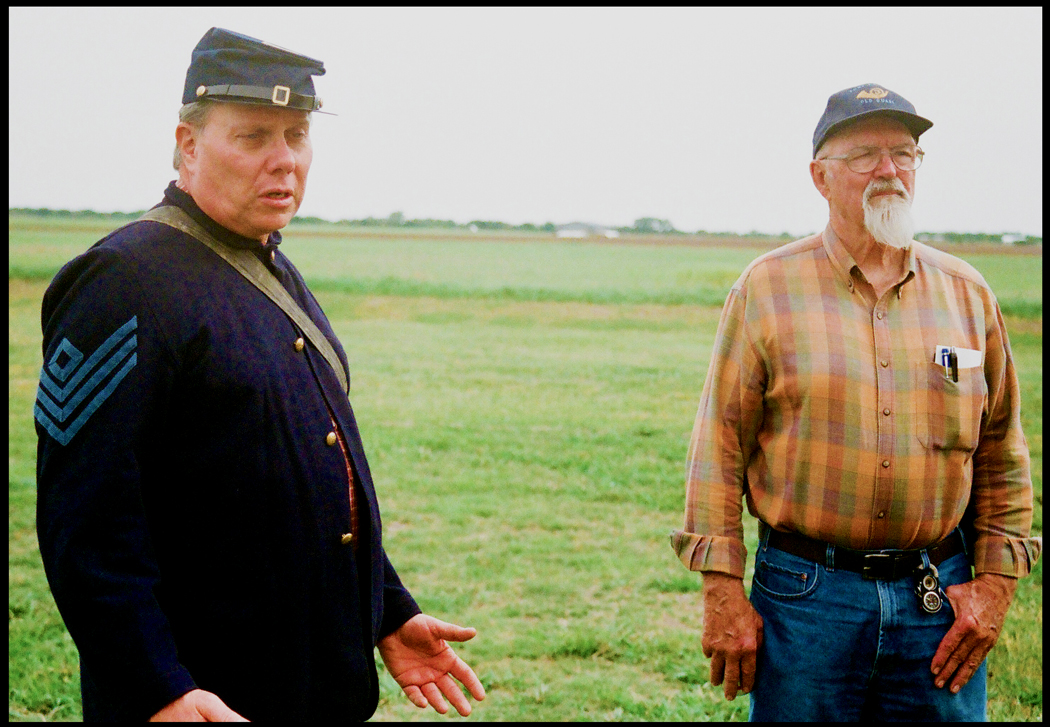
This photo of George Elmore (left) and Leo Oliva dates to 28apr2012. I was again speaking about Wynkoop at Fort Larned, and on this day we had walked outside the perimeter of the fort to the building that Agent Wynkoop rented from the post trader for his Cheyenne and Arapaho agency. George was one of the key players in recreating the building on its exact location. Leo has also been key to restoring and retaining Kansas history, and this includes the Pawnee Fork Tsistsistas-Dog Man-Lakota village that Maj. Gen. Hancock destroyed in April 1867. Both have been major players in my writing life. (photo © Louis Kraft 2012)
We met then ranger—now chief ranger—George Elmore. It was the beginning of a friendship that is ongoing to this day. He gave us a complete tour of the fort, which I photographed and was key for The Final Showdown (Walker and Company, 1992). He asked if we could stay at his home and revisit on the following day. We couldn’t, as we had a flight to catch in OKC.
The last pitches are slowly moving forward. They will be long, detailed, and specific to the venues. If I land one, great; three, much better; all five, and I’ll be in talk heaven (at the moment I’m considering adding sixth pitch, as I know that one no longer has funding). I’m treating them with the same seriousness as I present my book proposals. Although two had been discussed on the phone multiple times (and one has been followed up with a full-blown written pitch), they aren’t a slam-dunk (a basketball term) for the people who opened the door to me must make a decision (see below).
True West and LK’s magazine writing future
My relationship with True West magazine ended when my article, “The Good Ol’ Boys,” was published in June 1990 (see the below caption for details). Before the article was published the then owner/publisher killed it until one of the featured people in it was purged from my story. I considered the owner’s decision heinous and never wrote for True West again. Yeah, I’m clear on who I will write for, and they are my decisions. I pitch them, they contract my stories/books, but the bottom line is that they work for me. This has been in place for a long time and has caused a lot of anger directed at me by them.
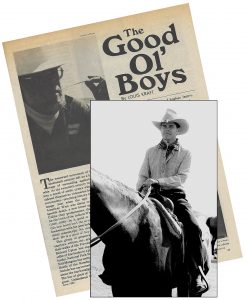
Early on then True West editor John Joerschke and I became friends. I pitched him on this article about people who presented history to the public in different ways, and he bought it. It dealt with four people: Gary Helms and his re-enactor cavalry regiment; Jerry Russell, who created the Order of the Indian Wars (and it is as we still know it today); Jim Court, former superintendent of the then Custer Battlefield National Monument; and Mike Koury, who is one of the best speakers I’ve ever listened to and current head of the Order of the Indian Wars. Yes, back in the day, this magazine was little more than newsprint and the pages bled. I had many pictures in this article to illustrate the stories, but just prior to publication, and, repeating myself, the then owner of the magazine—who, for some reason didn’t like Mike killed the section on him. The article was printed two issues after Mike had been purged from the story. This didn’t sit well with me, and again repeating myself, I never again wrote for the magazine again until Meghan Saar approached me in 2011 (see below). For the record LK knows how to ride a horse, and has for decades. (photo of Jerry Russell on the first page of the article & LK on horseback © Louis Kraft 1987 & 1989)
Hey, I write for me. My subjects are mine, and when I buy into them they are a marriage until death due us part. The books have beginning and ending lives, but articles and talks (whenever I am lucky to land them) can continue until I’m 130 (this is a joke, and yet it isn’t, for I’m doing everything possible to make this happen—the key is my brain, and it functions with my Corvette pedal to the floor every day). Don’t believe me? I have tinnitus, which is nasty. Since July 5, 2019, when I began the Sand Creek copyedit, and until September 22, my brain has been so-keyed into what I’m doing, the twenty-second of this month was the 17th day wherein my tinnitus was gone—totally gone. You don’t know what this feels like until you experience it. … The clear sound you hear, and that is without a buzz. Let me tell you that It’s heaven. How? Why? For me, total focus!
But, but, when Ned Wynkoop and the Lonely Road from Sand Creek (OU Press, 2011) was published the then True West managing editor Meghan Saar pitched me on doing a one-page article that would be printed along with a a surprise for me (good stuff by her). She came through big time, even though we never hit it off. She’s gone, for whatever reason, but I am forever grateful to her for reaching out to me.
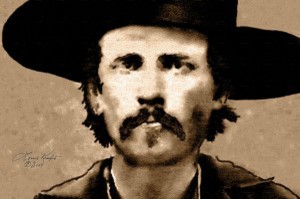
LK art of Wynkoop that has been published in numerous books and magazines over the years. (art © Louis Kraft 2007)
The best part of the two 2011 True West pages was historian R. Eli Paul’s paragraph review of the Wynkoop book: “Louis Kraft’s special skill as a biographer is taking a figure from Western history—one whom the general public should know but does not—and telling the story of a meaningful, significant life. He did this expertly with Lt. Charles Gatewood of the Apache wars and now has repeated the feat with frontiersman Edward Wynkoop. In an American history that trumpets great ‘last stands,’ Wynkoop spoke out against the mistreatment of the Plains Indians and made his own stand of conscience, one to be studied, remembered and admired.”
Hey folks, no Wynkoop book; no Sand Creek book. The connection is huge,
and inter-linking connections have been key to my entire writing life.
True West editor Stuart Rosebrook and I connected in May via emails and a good phone conversation, and the focus was LK writing for True West. My daughter and I traveled to Tucson, Arizona, in June for much-needed R&R for both of us, a chance to just be us and hang out, and for LK to do some work. We succeeded on all fronts, but the key to this trip to Tucson was Stuart. We didn’t attend the Western Writers of America convention in Tucson, but Stuart did. On one of the evenings we got together in the convention hotel’s bar. I was prepared for pitching a series of articles on “The Key Players of the Sand Creek Saga.” Some of them definitely interested Stuart.
That was then; this is now (24sept2019)
Stuart and I spoke about my Sand Creek article proposal for True West’s 2020 schedule that he has been preparing, and about our working relationship moving forward. Let me say this: LK is one happy cowboy as he dances around Tujunga House.
Starting with what we had shared in May, June, and then my official August 29 proposal for a series of articles, we discussed the direction of the magazine next year and how I might fit into it on an ongoing basis. Hey friends, this is good stuff for me. Let’s put this another way—I’m looking forward to partnering with Stuart and True West in 2020 and beyond. The offer is there, and it is something that I want to happen.
I know some of the details, and certainly about the various pieces that I’ll be writing in the future. Some will be based upon my proposal, and some will not (they’ll be from my book-writing past). We discussed True West becoming a home, a base, with an ongoing relationship with me as a correspondent, contributor, and editor. This is a win-win for me and hopefully for Stuart and True West. I know some of the early details of what we’ll be doing, but now is not the time to share them. One thing is certain, Cheyenne chief Black Kettle will be my first feature for True West.
Gordon Yellowman
Gordon and I have known each other since 1999, and we respect each other.
Photo of Gordon Yellowman (left) and Harvey Pratt. Both are Southern Cheyenne chiefs, and I took this photo of them on the Washita Battlefield NHS overlook on 11nov2011, after Harvey spoke about Cheyenne warriors in the past and during modern USA wars, and Gordon blessed the Washita village site. … You know my relation with Gordon, but I also have one with Harvey, due to his great friendship with historian Dee Cordry. There was, and is, key documentation that I had but in the 20th century Oklahoma blocked it from researchers. Harvey had this documentation and kindly allowed Dee and myself to use it. Harvey’s action is one of the kindest that I’ve experienced during my entire time as a writer. (photo © Louis Kraft 2011)
As said above, Gordon’s “Sand Creek” painting is key to Sand Creek and the Tragic End of a Lifeway, and to repeat myself, I’m thrilled. This has opened the door to hopefully a friendship, and perhaps the possibility of us talking together and doing signings. He originally pitched me on joint signings; I countered him on doing joint signings and talks. He agreed, and we’re doing what we can to make this happen.
Major update!
Kevin Mohr, chief of interpretation and operations at the Washita Battlefield NHS, called me on 19sept19 regarding an oral pitch I had presented to him a while back. Yes!!!! He wants Gordon and I to talk at the Washita in November 2020. Their bookstore will handle ordering the books (which I love, as I don’t have to do anything to get them to Cheyenne) and they already have prints of Gordon’s magnificent art of the Sand Creek village. … Ladies and gents, next year I will re-emerge from my forced retirement from giving talks. And honestly, I love doing talks more than acting on the stage, as I know what I’m going to talk about (and only attempt to memorize quotes), and it is a one-shot occurrence wherein my focus cannot waver. For me, talks are a big part of my life, and returning to doing them is long overdue.
Better, I am absolutely thrilled that this event will happen with Gordon and myself.
Gordon Yellowman and LK (right) after the completion of the Washita Battlefield NHS symposium on 7dec2011. (photo courtesy of the Washita Battlefield NHS)
I can’t say enough about Kevin’s efforts to help me obtain permission to use two details from artist Steven Lang’s magnificent mural of the attack on Black Kettle’s village on 27nov1868 that is displayed at the battlefield; a tragic day, for on it the chief and his wife (Medicine Woman Later) died (my opinion is a little stronger than “died”). The two details will add great value to the Sand Creek book, and I will forever be grateful to Kevin for his efforts to make this happen, as well as bringing Gordon and myself to the Washita next year.
Oh, I’ll be talking about Black Kettle in November 2020.
LK’s book-writing future is out there
I have certainly discussed my writing future on these blogs and elsewhere on the internet. It is my proposed future. … But as the legendary New York Yankees catcher Yogi Berra once said, “It ain’t over till it’s over.” This is a paraphrase of his great quote, but in regards to LK’s writing future, it is right on the money: “It ain’t over till it’s over.”
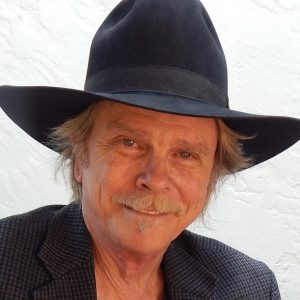
This LK portrait was taken in August 2018 when OU Press Marketing requested photos for the dust jacket and publicity. Pailin shot them on the 4th, and they were exteriors on the Tujunga House back porch with a hat as well as interiors in front of a bookcase without a hat. She captured a lot of a great shots, but this was not one of the closeups that I delivered to OU Press (perhaps as it was my favorite and I wanted to use it elsewhere). I have since sent it to them, but without a response. (photo © Pailin Subanna-Kraft 2018)
This means one thing: what I said in the recent past, what I say here, and what I say in the future may change for one simple reason—Kraft is fickle as he travels that road where the research and words lead him. My future is before me, and I’m going to walk into it with open eyes.
At the moment, and this has been since beginning the Sand Creek copyedit on the evening of July 5, I have been working seven days per week every week. This has caused health problems, and I’m worn out, but these days are not about to end in the near future. I have a lot that I must complete for Sand Creek and the Tragic End of a Lifeway to see publication. Trust me, for this is number one in everything that I do at this time. Number two is setting up articles and talks, for this is major for my 2020 life. Finally I intend to put my future book writing in place, and it will not supplant my Sand Creek talks and articles in 2020. At the same time it will dominate my book writing future.
Finally, and for those of you who don’t know who I am or what I do
I am simply a person who has followed my winding trail to today. I have always had focus, but when I have been faced with a projected goal that is beyond my grasp, I have never—never—continued on a path that has no chance of success. Again, never!
My entire life has been interconnected since I was a boy. Everything was in place by the time I graduated from the sixth grade, although I didn’t know it until perhaps two decades later. Everything. The key was my parents, both of whom were open to all people regardless of race, color, or religion.
The house I grew up in was an open door to everyone. I never realized this until many years later.* My mother and father also supported every choice I made during my growing years. It didn’t matter if they agreed with what I wanted to do or not, for they backed me 100 percent. But not with money, for here I was on my own. I learned the importance of greenbacks early on. My first paying job was delivering newspapers (the Los Angeles Daily News; think it had another name back then; the Green Sheet????) while in elementary school. I would eventually be laid off when the paper decided to transition from bicycle delivery to automobile delivery, but then worked throughout high school and collage as I wanted a university education. Early on, my father had told me that he couldn’t and wouldn’t pay for my education. Back in the dark ages obtaining a good education was doable (we all know how times have changed and the cost of education is now obscene). I wanted it, and although working, I graduated in four years, and without checking completed between 16 and 18 extra credits. In my final semester there was an upper division anthropology class on American Indians. I had not had any anthropology classes, and this bothered the professor. I told her that I didn’t need it for graduation, and that I wanted to learn about Indians. She allowed me to join the class. However, near the end of it she shook her head and smiled. “Anthropology is nonfiction, and your term paper is fiction.” “The class description and your handout on the term paper didn’t mention the word, ‘fiction’ or ‘nonfiction.'” She wanted to grind her teeth; she wanted to rip me to shreds. She didn’t. “I’ll accept your paper, but it will cost you a grade.” “Thank you.” I received a “B” for the paper and a “B” for the class. My paper was about an Apache teenager who was on a journey to become a man (based upon facts). In spring 1969 I was clueless of my future.
Shortly after my family migrated from New York to California, Doris Day had a song that my parents bought on 78rpm, “Que sera, sera, what will be will be.”* They played it all the time in our new home in sunny SoCal. They loved it, and so did I. This could be my theme song. I don’t have it. … Maybe I should get it so that I could listen to it again.
A hint of the future
Years back I had stopped listing future blogs, for the simple reason that some of them never happened. Today is special for I’m going say a little about the next blog.
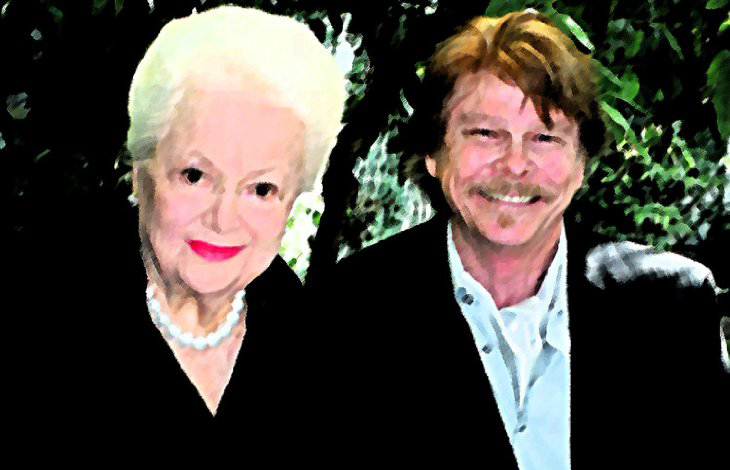
I based this art of Olivia de Havilland and myself from photos taken at her Paris, France, home in 2009. When I posted it elsewhere on social media I was accused of creating it from scratch, and the reason was that I had not spent time with OdeH (the implication was clear—I did not know her and had never met her). For the record, I never say I do or did something if I didn’t do it. She is a wonderful person, and I’ve been lucky to be a part of a small portion of her life. (art © Louis Kraft 2013)
I know exactly what the next blog will discuss—my writing future. It is going in directions that have been in place for decades. This is no surprise for me, but it may be a major shock for some of you. As always I’ll mix and match subjects that are of importance to me. Pailin pitched me on a subject she wanted me to photograph and document. It was right up my alley, and I immediately agreed to her request, but health and deadlines prevented this from happening. My loss (and certainly Pailin’s, for I let her down). At the same time some of what is ongoing scares the hell out of me. This blog will go live at the end of December. Hopefully it grabs your interest.
Until then, vaya con dios, amigos y amigas.

